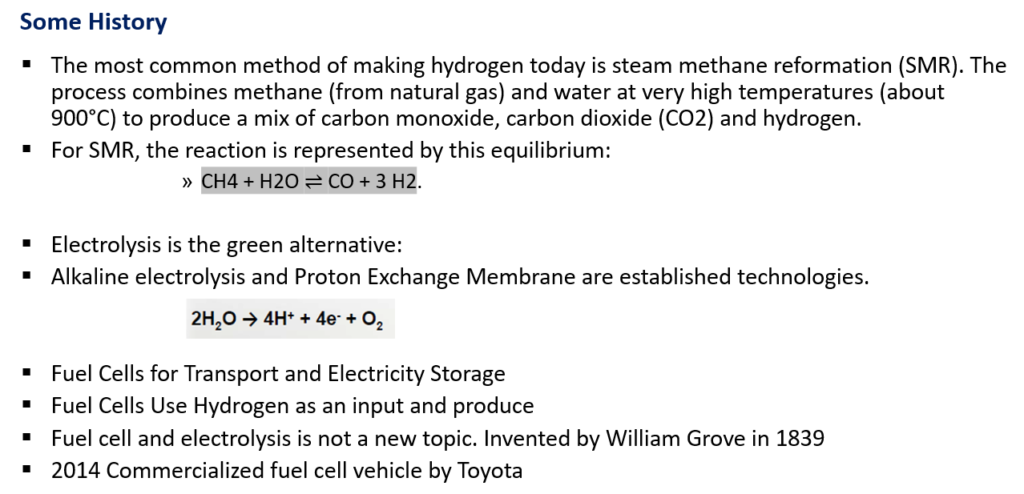On this webpage I address the issue general issues associated with evaluating the costs and benefits various issues associated with hydrogen production. The process of making hydrogen using electricity with water does not produce any carbon emissions. The files, spreadsheets and videos on this page allow you to download files associated with the A-Z analysis. This includes an analysis of production of natural gas (CH4) using a steam methane reactor (SMR) with alternative assumptions with respect to emission costs. I also discuss blue hydrogen and ammonia production. This illustrates how the assumption of electricity production emissions from natural gas affects the analysis. The SMR analysis illustrates the importance computing simple efficiency measures that can translate the cost of natural gas (USD/MMBTU) or electricity (USD/kWh) to the cost of hydrogen in USD/kg. For the SMR this is MMBTU/kg and for electrolysis, the efficiency is measured by the well known kWh/kg statistic. Once the levelized cost of the SMR is established, the electrolyzer cost is evaluated. This analysis considers use of renewable energy for electricity with low capacity utilization versus cost of electricity from natural gas and other fuel from merchant markets. This analysis includes the methods of accounting for the life an degradation of the stack.
After establishing the costs of the SMR and Electrolyzer, the downstream costs of compression, storage, transport, and dispensing. Each of the downstream elements includes different drivers that can be evaluated using levelised cost. This includes storage cost that depend on the time in storage; the transport cost that depends on distance and time; the cost of dispensing that depends on the time to dispense and the load factor of dispensing the hydrogen. Once the downstream cost is established, the cost of vehicles and the cost of ammonia is discussed. On this page, I have included the files that address the different components of the levelised cost.
.
.
Power Point Slides with Overview of Green and Blue Hydrogen for Credit Analysis and Valuation
.
Overview of Hydrogen Analysis with Levelized Cost
.
The file attached to the button has analysis that is in the video. The video works through the levelized cost of different colours of hydrogen with and without incentives to hilight the key issues without too much complexity for things like degradation of fuel use and separation of the stack from the other equipment.
.
.
.
Tell Me What’s Wrong with This Simple Storage Analysis
Sometimes it is so much more difficult to demonstrate things in simple terms than with large complex models. The problem is that you have to go through the complex models to finally arrive at the simple cases. Two examples below are the horrible BS I hear so much about how expensive hydrogen is to store. I may be more expensive than natural gas, but the comparison is not close when you compare to electricity storage with a battery. This is illustrated below.
.

.
.
Files for Hydrogen Analysis
The power point slides can be downloaded below. The size of the file is large so I had to split the slides into two parts.
The excel files that work through the levelised cost and include the levelised cost calculator are shown below.
.
.
Excel File with Comprehensive Levelised Cost of Ammonia and with Financial Model of Ammonia
.
.
.
.
.
.
.
.
.
I made an introductory video that works through this.
Cost of SMR and Electrolyzer
Alternatively, the process of using a Steam Methane Reactor and making hydrogen from natural gas — CH4 — will produce carbon when the Hydrogen is extracted. Most of the writing on hydrogen presumes that the cost of hydrogen from an SMR has a much lower cost than from an electrolyzer because of the direct use of natural gas. This page investigates how you can compute the cost of an SMR with alternative natural gas prices and compares the cost of the SMR with the cost of an electrolyzer that may take advantage of very low cost electricity when the prices are very low or produce hydrogen in proximity of a solar and/or a wind project.
In this page I illustrate how I use exercise files that I have created for various different issues. I demonstrate that the crucial issue in working through hydrogen is evaluating the efficiency and the fuel costs. As the fuel cost rather than the capital cost is the driver of hydrogen cost, alternative strategies that only produce hydrogen from an electrolyzer are demonstrated. For example, an electrolyzer may run at a low capacity factor to only use very cheap solar power. The cost of this strategy is affected by the fact that the stack of an electrolyzer is driven by the hours of use rather than by a simple chronogical measure of time.
The file attached to the button below includes some excel exercises that work through different strategies.
My comments on hydrogen are in the power point slides below. I update this some time and you can fine the updated version on the google drive.
